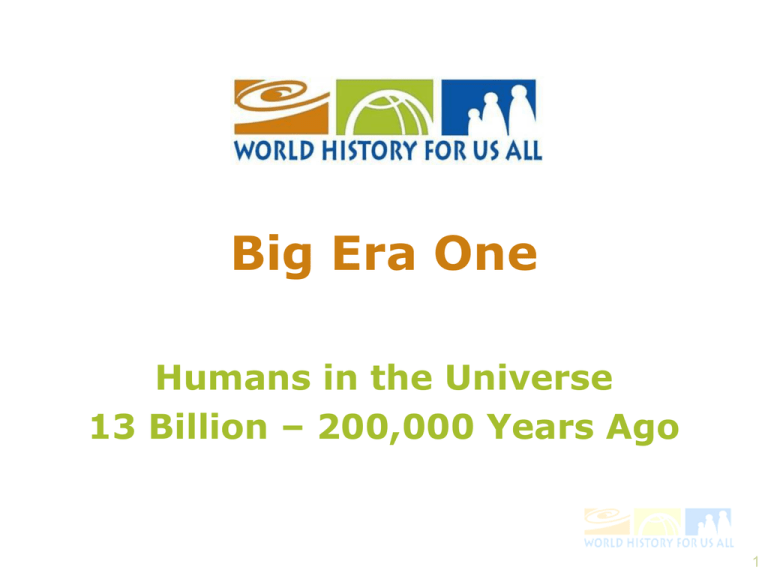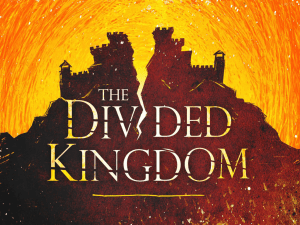Big Era 1 - World History for Us All
advertisement

Big Era One Humans in the Universe 13 Billion – 200,000 Years Ago 1 Welcome, fellow time travelers! Me llamo “Mundo!” Nice to make your acquaintance. I don’t know how you found me, but I think you’ll be glad you did. Since you’re here and so am I, let’s take a little trip, huh? 2 I’m glad you’re here! People have been kind of ignoring me lately, so I’ve been thinking a lot and wanted to share this story I’ve been writing. It’s about me, of course (it’s my story, right?), but it’s about you, too... Let me start with a couple of questions I’ve been thinking about... 3 How did the universe come to be? Where did our Earth come from? How & when did we humans appear on Earth? 4 Deep questions, huh? Yeah, but I’m not the only one asking them... 5 All peoples have explanations of our origins. The Maidu people, native to California, say that Earth Starter made the world from some green slime Turtle brought up from deep underwater. He made humans from red earth mixed with water. … And the Chinese used to say that Phan Ku – no thing, not yet born – burst from a hen’s egg and became the Great Creator. 6 Scientists offer a different explanation, based on evidence gathered from sources on earth and in space. Here’s what they might say: Long ago, there was no time... There was no space... But 13 billion years ago... things changed. 7 BANG! 8 Where there had been nothing, now there was everything. The whole universe – tiny, and fantastically hot. For an instant, it expanded faster than the speed of light. Then it slowed down but kept expanding, as it still is. 9 Big Eras 2-9 Big Bang As the universe cooled down, clouds of hydrogen and helium gas began to gather together, their centers getting hotter and hotter. 13 bil yrs ago Big Era 1 10 And when they were hot enough, the hydrogen atoms began to fuse together with the power of millions of hydrogen bombs. 11 STARS WERE BORN! 12 They clustered together in vast galaxies, each containing billions of these new stars. Big Eras 2-9 Big Bang I can’t see us yet... Stars & Galaxies 13 bil yrs ago Big Era 1 12 bil yrs ago 13 Four and a half billion years ago – when the universe was already two-thirds as old as it is today – a star was born near the edge of a galaxy we call the Milky Way: Our Sun & Planets Big Eras 2-9 Stars & Galaxies Big Bang OUR SUN! 12 bil yrs ago 13 bil yrs ago Big Era 1 4.6 bil yrs ago 14 Around the sun, wisps of matter were drawn together by the forces of gravity to create the planets of our solar system… 15 …Including the third rock from the sun: OUR EARTH! What a cute baby, huh? 16 The early earth was incredibly HOT. Heavier metals melted and sank to the center, lighter metals rose to the surface, and gases bubbled up to make the earth’s first atmosphere. Anybody got something for a stomach ache? 17 By four billion years ago, the earth had cooled enough for water to condense into oceans. And so the earth turned blue. The surface hardened into thin “plates” floating on the molten materials underneath. Those “plates” float on the surface to this day, constantly changing the landscapes and weather patterns on the earth’s surface. 18 Where the plates collided, great mountains were formed... 19 ...and where they tore apart, melted rock poured out from under the surface. 20 Deep within the newly formed oceans, complex chemicals were created using volcanic heat for energy. First Life Big Eras 2-9 Our Sun & Planets Stars & Galaxies Big Bang Some of these chemicals became so highly organized that they formed cells – the first LIFE ON EARTH! 4.6 bil yrs ago 12 bil yrs ago 13 bil yrs ago Big Era 1 3.8 bil yrs ago 21 Living organisms changed the atmosphere, adding oxygen. Cells developed that could “breathe” oxygen... 22 First Life Our Sun & Planets Stars & Galaxies Big Bang ...and, about 600 million years ago, the first multicellular organisms arose in the earth’s oceans. Multi-Celled Organisms 3.8 bil yrs ago 4.6 bil yrs ago 12 bil yrs ago 13 bil yrs ago Big Era 1 600m yrs ago Big Eras 2-9 23 The first animals appeared not too long after! 24 First Life on Land Big Eras 2-9 First Life Multi-Celled Organisms After a while, some animals moved out of the oceans and onto the land. 400m yrs ago 250k yrs ago Today 600m yrs ago 3.8 bil yrs ago Scale of Life on Earth 25 First Dinosaurs Big Eras 2-9 First Life on Land Dinosaurs were the most successful of the early land animals... Today 220m yrs ago 250k yrs ago 400m yrs ago Scale of Life on Land 26 ...but about 65 million years ago, a giant meteor came crashing down to earth... Big Eras 2-9 First Dinosaurs First Life on Land ...and the dinosaurs were no more! Dinosaurs Disappear Today 67m yrs ago 250k yrs ago 220m yrs ago 400m yrs ago Scale of Life on Land 27 This left a new class of animals dominant on the land. MAMMALS! 28 Over time, a particular group of mammals emerged that lived in trees. To survive in that environment, these mammals needed 3D vision and large brains to process visual information. They also needed hands that could grip with precision. (Imagine living in a tree without any of these. You’d fall out!) These mammals were the first PRIMATES. 29 Then, about 7 million years ago in Africa, a branch of those primates became the first to stand upright. These were the first HOMINIDS. Different hominids lived on earth over the next 7 million years, some at the same time as others, but only one survives to this day... US!!! 30 First Hominids Big Eras 2-9 Dinosaurs Disappear The earliest hominids lived in small, familysized groups. They gathered plants, insects, and small animals, and they occasionally scavenged the meat of larger animals killed by predators. 7m yrs ago 250k yrs ago Today 67m yrs ago Scale of Life after the Dinosaurs 31 Today 4 – 1.5m yrs ago Big Eras 2-9 Australopithecines 250k yrs ago 7m yrs ago First Hominids The first hominids had brains about the size of a modern chimp’s. Over time, new species developed ever-larger brains, and they began to make more and more complex tools. The Australopithecines likely used sharp sticks to dig for food... 32 Big Eras 2-9 ...while Homo habilis hominids, a later species, were able to make stone tools. They chipped ‘flakes’ of stone from large rocks and used those flakes as knives. They also used the leftover ‘core’ to scrape out hides and do other jobs. Homo habilis Today 250k yrs ago 2.4 – 1.6m yrs ago 1.5m yrs ago 4m yrs ago Australopithecines 33 Homo erectus Today 1.8m – 27k yrs ago 250k yrs ago 2.4m yrs ago 1.6m yrs ago 1.5m yrs ago Homo habilis Australopithecines 4m yrs ago Big Eras 2-9 Homo erectus hominids, which lived on Earth for almost two million years, were probably the first ones who could control and use fire. They were also the first to leave Africa. Their fossils have been found as far away as China and Java (in modern Indonesia). 34 Social relationships among our ancestors were complex. Like modern chimpanzees, early hominids must have been quite clever, with a great deal of social cooperation and group politics. They cared for each other, especially their children. WOW! These early ancestors of ours sound a lot like us! 35 Well, in some ways that’s true – but this species was different in many other respects from our species. We have no evidence, for example, that they had art, religion, or language. ART RELIGION LANGUAGE 36 So, what’s so special about us? What makes us HUMAN, and how did we BECOME human? 37 Well, you’ll just have to wait for BIG ERA TWO to get the answer to those questions! End of Big Era One 38






